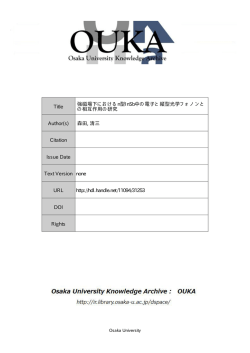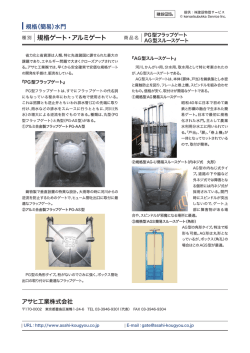
論 文 内 容 要 旨
論 文 内 容 要 旨 (NO.1) 氏 名 学位論文の 題 目 Md. Mohi Uddin 提出年 平成 25 年 Gate Controlled InSb Quantum Well and its Application to Resistively Detected Nuclear Magnetic Resonance (ゲート制御された InSb 量子井戸とその抵抗検出核磁気共鳴への応用) 論 文 目 次 Table of contents Abstract Acknowledgements Dedication Contents List of figures List of tables Chapter 1 Introduction 1.1 Motivation 1.2 Scope and organization of dissertation Chapter 2 Background 2.1 Heterostructure 2.2 The Hall effect 2.3 Landau levels 2.4 Shubnikov-de Hass oscillations and the quantum Hall effect 2.5 Dynamic nuclear polarization (DNP) 2.5.1 Hyperfine interaction 2.5.2 DNP in quantum Hall ferromagnet (QHF) 2.5.3 Pump and probe technique 2.6 Self-consistent Schrödinger and Poisson (SP) solution 2.7 Two carrier model Chapter 3 Materials system and device fabrication techniques 3.1 Heterostructure design 3.2 Sample fabrication 3.2.1 Photolithography 3.2.2 Mesa etching 3.2.3 Ohmic contacts 3.3 Top gate fabrication using atomic layer deposition (ALD) technique 3.3.1 Mechanism of ALD technique 3.3.2 Sample preparation for top gate 3.4 Top gate metallization 3.5 Wire bonding 3.6 Dilution refrigerator 3.7 Measurement system Chapter 4 Characterization of InSb QWs with atomic layer deposited gate dielectrics 4.1 Introduction 4.2 Sample preparation 4.3 ALD recipe 4.4 Gate dielectric Al2O3 deposition 4.5 Magnetotransport measurement 4.6 Analysis of parallel conduction 4.7 Conclusion Chapter 5 Gate depletion of an InSb two dimensional electron gas 5.1 Introduction 5.2 Sample preparation 5.3 Complete depletion of the two dimensional electron gas 5.4 Analysis of interface 5.5 Conclusion Chapter 6 Measurement of nuclear-spin relaxation time T1 6.1 Introduction 6.2 Sample preparation 6.3 Magnetotransport characteristcs 6.3.1 Resistively detected nuclear magnetic resonance (RDNMR) 6.4 Nuclear-spin relaxation time T1 6.4.1 Filling factors and temperature dependent T1 6.5 Conclusion Chapter 7 Concluding remarks 7.1 Summary 7.2 Future works Appendix A Appendix B Bibliography List of Publications and Presentations Abstract Narrow band-gap semiconductor InSb has long been considered as potentially exciting materials for nextgeneration high-speed, low power electronics and spintronics applications owing to its unique materials properties including high room-temperature mobility (77000 cm2/Vs) due to small effective mass (0.014me) and a giant Landé g-factor (~ -80 in quantum well) as a result of strong spin-orbit coupling. Silicon-based complementary metal oxide semiconductor (CMOS) scaling is reaching its physical limit to meet Moor’s law. The power density (P) is getting a serious issue with higher operating frequency and larger integration density in a single chip. P can be greatly reduced by using low operating voltage (P V2). The InSb is a strong solution among the III-V semiconductors, because it has very high carrier velocity at low electric field, which means the transistors can maintain high performance at low operating voltage, using reduced power. Moreover, strong spin orbit coupling of the InSb is particularly appealing for spintronics applications, for instance electron spin manipulation in a spin field-effect transistor (spin-FET). A good gate controllability of InSb QW is essential for these device applications. High nuclear-spin isotopes In (I = 9/2) and Sb (121Sb I = 5/2, 123Sb I = 7/2) and a giant Landé g-factor of the InSb have attracted renewed attention for nuclear-spin based measurement and quantum information processing (QIP). By taking advantage of a large g-factor in the tilted magnetic field configuration, successful resistively detected nuclear magnetic resonance (RDNMR) has been demonstrated in the quantum Hall ferromagnet (QHF) using a single InSb two dimensional electron gas (2DEG). This achievement is exposed the door to extend the semiconductor materials system for nuclear-spin based measurements and nuclear-spin electronics applications other than well studies GaAs. Gate controlled InSb QW is required to uncover the properties of the electron spins in the QHFs by measuring nuclear-spin relaxation time T1 at different filling factors. Additionally, control and detection of multiple quantum coherences of nuclear-spins in a nanoscale region such as quantum point contact (QPC) by all-electrical means also entail a gate controlled InSb QW for future QIP. However, experiments have so far been limited because of difficulty to deposit a high quality insulating film on the InSb QW. The purposes of this study are to fabricate high quality top gated InSb QWs with atomic layer deposited (ALD) Al2O3 gate dielectric and investigation of temperature dependent T1 at different filling factors () using precise pump and probe technique. We have successfully fabricated gate controlled InSb QWs using atomic layer deposition (ALD) grown Al2O3 as a gate dielectric. The density of two dimensional electron gas (2DEG) in the QW is efficiently tuned by gate voltages (Vg) thanks to the good interface of Al2O3/InSb, but saturates at large negative Vg. This triumph allows us to study the importance of the layer sequence in gate controllability. At large negative Vg, the valence band (VB) touches the Fermi level (EF) due to the narrow band gap of top surface layer (InSb) of the QW results the hole accumulates at the surface of the QW and screens the external gate electric field, which has been elucidated by a self-consistent Schrödinger-Poisson (SP) simulation. Accordingly, the 2DEG is not completely depleted in such a QW. Based on the SP simulation, we predict that the 2DEG would be depleted in an InSb QW with a wider-band-gap AlxIn1-xSb surface layer that is expected to prevent the hole accumulation by keeping the VB far from the EF. We have revealed experimental evidence that the 2DEG is completely depleted in the QWs with a widerband-gap (Al0 1In0 9Sb) surface layer. The interface of Al2O3/Al0 1In0 9Sb shows a very weak pinning of the EF that ensures complete depletion of the 2DEG by application of a small gate voltage (~ -0.9V). This is also reflected by excellent gate controllability with a linear, sharp, and almost hysteresis free behavior in the InSb QWs with wider-band-gap (Al0 1In0 9Sb) surface layer. This achievement paves the way to fabricate split-gate defined InSb nanodevices (e.g., QPC). The success of gate controlled InSb QWs allows us to perform pump and probe technique to investigate the properties of electron spins configuration at the quantum Hall ferromagnet (QHF) by measuring temperature dependent T1 at different filling factors. Collective spin excitations in the domain walls enhance DNP in the QHF around filling factor 1.86 characterized by a short (~ 60 sec) and temperature- independent T1. On the other hand, relatively long (~ 400 sec) and temperature dependent T1 with following Korringa law have been demonstrated in the absence of the domains as well as collective spin texture at around 3. Collective nature of the QHF at the Landau level crossing around 2 has been confirmed in this experiment. In addition, the large Zeeman, cyclotron and exchange energy scales of the InSb 2DEG favor to demonstrate the RDNMR signal at elevated temperature up to 6 K. Our results clearly show that the InSb 2DEG is a suitable candidate for implementation of the high temperature nuclear-spin based QIP. 論文審査の結果の要旨 InSb 系は小さい有効質量や大きなスピン軌道相互作用により、次世代高速デバイスやスピントロニクス デバイス材料として注目されてきた。さらに、g 因子が大きいことから傾斜磁場下でスピン状態の異なるラ ンダウ準位が交差し、高感度の抵抗検出核磁気共鳴(NMR)が可能になる点からも興味が持たれてきた。し かし、狭ギャップ半導体の特徴として、そのゲート制御が難しく、例えば GaAs 系の半導体で実現されてい るようなポンプ・プローブ NMR を行い、二次元系のスピン物性に関してきちんとした議論をすることはでき なかった。そこで、本学位論文では、最初に、絶縁膜堆積技術を用い、優れた金属-絶縁体-半導体構造を作 製し、良好なゲート制御性を InSb 二次元系で実現することを目指した。実際に、原子層堆積(ALD)技術を 用い、Al2O3 の堆積条件を工夫することで、ゲートリークの小さい金属-アルミナ-半導体構造を実現し、 InSb 二次元系でゲート制御性が得られることを示した。さらに、研究を進める中で、ヘテロ構造のデザイ ンが重要な役目を果たし、表面に狭ギャップ InSb 層が存在する場合にはアルミナ-InSb 界面への正孔蓄積 により二次元電子系が空亡化できなくなることを明らかにした。この知見を基に研究を進め、表面が Al0.1In0.9Sb であるヘテロ構造で完全な二次元系の空亡化が可能になることを示した。さらに、シュレーディ ンガー・ポアッソン・シミュレーションとの比較から界面準位密度を定量的に明らかにし、優れたゲート制 御性を反映して、界面準位密度が小さくなることを確認した。得られたゲート制御性は InSb 二次元系とし て世界最高レベルであり、この研究により InSb 系ナノ構造作製に向けた障壁が取り払われた。さらに、本 研究で実現された優れたゲート制御性を抵抗検出 NMR 実験に応用し、InSb 系ではじめてポンプ・プローブ NMR 実験を実現した。具体的には傾斜磁場下で異なるスピン状態が縮退し、充填率 2 付近でドメインを有す る擬スピン量子ホール強磁性状態が形成される条件を探し、この状態で核スピンを電流により動的に偏極し た後、ゲート制御により様々な充填率に変化させて、その状態での核スピン緩和時間を測定した。その結果、 ドメインが存在する充填率 2 の近傍では温度に依存しない短い核スピン緩和時間が測定されるのに対し、充 填率 3 付近では温度に依存するより長い緩和時間が測定された。充填率 2 付近での擬スピン量子ホール強磁 性状態の存在を輸送特性から議論したものは他にも AlAs などで研究例があるが、核スピン緩和時間から擬 スピン量子ホール強磁性状態の電子スピン状態を明らかにしたのは本学位論文が初めてである。 以上の内容は、自立して研究活動を行うに必要な高度の研究能力と学識を有することを示している。した がって、Md. Mohi Uddin 提出の博士論文は,博士(理学)の学位論文として合格と認める。
© Copyright 2026


